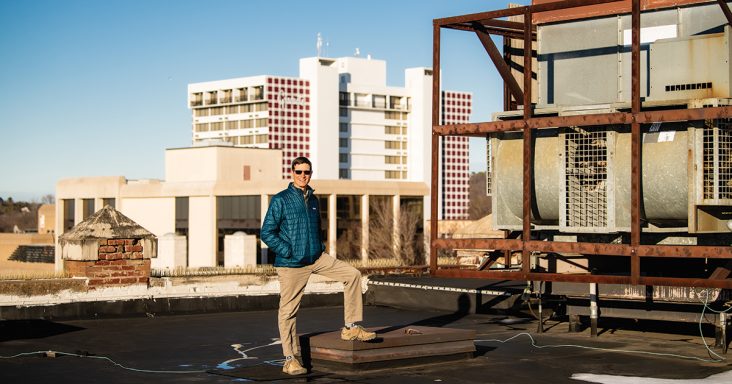NWA agencies make move to be more energy efficient
by February 21, 2022 1:15 pm 1,089 views

Peter Nierengarten, environmental director for the city of Fayetteville.
Public entities such as schools considering upgrading ventilation systems in the wake of the COVID-19 pandemic have also looked to implement energy efficiency projects. Still, a 2018 plan to reduce emissions led the city of Fayetteville to seek such projects.
Lauren Waldrip, executive director of the Arkansas Advanced Energy Association, said renewable energy projects are trendy, but energy efficiency is the “sleeper” in the industry.
In Arkansas, public entities have saved $550 million due to energy efficiency projects through the state Energy Performance Contracting program since it was established by law in 2013, she said.
The Arkansas Energy Office helps state agencies, higher education institutions, cities, counties and school districts. According to the state website, the program is a tool for paying for efficiency upgrades such as lighting, chillers, boilers, water systems, and renewable generation. The state website includes a list of pre-qualified energy service companies with which organizations can work to complete energy efficiency projects under the program.
Rogers and Fayetteville are in different stages of completing projects through the program.
Peter Nierengarten, environmental director for the second-most populous city in Arkansas, said the Fayetteville City Council approved the city’s first energy action plan in 2018 with multiple goals, including the overarching goal to reduce greenhouse gas emissions by 80% from 2010 levels by 2050. One of the most noted first steps to reach the goals was to install solar arrays at the city’s wastewater treatment plants. The 10-megawatt solar project was completed in 2019 and offset the energy consumption of the plants.
“Now, we are looking at trying to reduce energy consumption at all the rest of our city facilities and buildings, and what energy consumption is left after we’ve reduced it as small as we can, we’re going to go do another solar project to offset the remainder of our electricity consumption,” Nierengarten said. “It’s part of our strategic energy action plan.”
The city is working on the project with Ireland-based Johnson Controls, a state-qualified energy service company, to improve the energy efficiency of buildings and equipment. Beneficiaries range from city hall and police and fire stations to park bathrooms, pump stations, and street and intersection lighting. Planned changes include transitioning to LED lights, weather sealing for doors and windows, water efficiency improvements and heating and cooling (HVAC) systems upgrades. The latter would consist of retrofitting older HVAC systems with new equipment, increasing energy efficiency and replacing units with obsolete refrigerants. That’s a separate environmental issue, he said.
Johnson Controls completed an audit to determine the energy savings potential and provided the types of HVAC equipment and lighting that’s available, he said. Each part of the project includes the expected energy savings, cost and return on investment.
The city is looking to borrow against the energy savings or pay outright for the project, Nierengarten said, noting the savings are guaranteed.
“We haven’t seen the final numbers yet on our project, so we haven’t decided one way or the other what we want to do,” he said. “We’ll have greater clarity on that … toward the end of this month.”
The city’s utility bill is more than $2 million annually, and the project is expected to provide about 20% energy savings. The city is looking at multiple project options, providing various levels of energy efficiency with a corresponding upfront cost, but it ranges from between $3 million and $5 million.
He said the city council would need to vote on completing the energy-efficiency work, but he expects it to start this spring. The city began working with Johnson Controls on the project about 10 months ago, and he would like to have the majority of the energy efficiency work completed this year. He added that the city might not complete the HVAC work until 2023.
OTHER PROJECTS

Alex Ray, director of business development, Arkansas, performance infrastructure for Johnson Controls, said while the Fayetteville project is being developed, the company is in the construction phase of an energy efficiency project for Rogers. The third phase regards the payback period, ranging from 15 to 20 years. He said Washington County entered the payback period of its project after completing the construction phase in 2021.
According to a news release, it’s the first Arkansas county to invest in solar through a performance contract. Washington County installed two solar arrays, including a 1.6-megawatt ground mount and half-megawatt rooftop array – the largest in the state, the release shows. It also retrofitted more than 3,200 lighting fixtures with LED lights, replaced 53 HVAC assets and installed energy management controls countywide. The project is expected to save nearly $21 million in energy and operations and maintenance costs.
Ray said Rogers is expected to see a 21% electricity consumption reduction in its project. The work includes installing new HVAC equipment, weather sealing, building controls and LED lighting. Construction is expected to be completed in late 2022 and consists of a 4.62-megawatt solar farm comprising three arrays. He said it would be the largest publically-owned solar investment in the state. Rogers will be the first Arkansas city with its operations to be 100% powered by a city-owned renewable energy plant. The life cycle of the solar farm is expected to be 30-35 years.
According to city records, in November, the Rogers City Council approved the $12.2 million project with Johnson Controls in a 5-4 vote.
According to a news release, the project is expected to account for more than $15 million in total utility and operations and maintenance savings.
Ray said Johnson Controls would provide an energy savings guarantee for 20 years on the project. The guarantee is significant for customers who finance the project’s cost using the energy savings to pay off the loan. He noted that if the energy savings don’t meet the guarantee, the company will cover the difference. Savings greater than the guaranteed amount would go to the customers.
Rogers paid outright for its project, but Johnson Controls offers various financing methods to mitigate customer risk. The company works with multiple banks to provide financing, including Bank of America, Wells Fargo and Crews & Associates. Johnson Controls also has acquired loans for customers to finance projects.
BROADER IMPACT
He said Johnson Controls has been in performance contracting longer than any other company in the United States and helped spearhead the Arkansas program. Since 2010, the company has completed 14 projects and has seven in the works in Arkansas. He noted that about half of the energy savings in the state program could be attributed to Johnson Controls projects.
According to a news release, Johnson Controls is projected to cut more than 1 million metric tons of carbon dioxide through the projects in the state. The projects are expected to deliver the same air quality results as taking 250,000 vehicles off the roads for one year while saving Arkansas taxpayers a combined $229 million, the release shows.
Johnson Controls also worked with Arkansas State University in Jonesboro to address deferred maintenance and provide sustainable solutions across eight other ASU campuses. The combined $39 million project included installing LED lighting, energy management controls and water conservation improvements for residence halls and other facilities, updates to HVAC and central plant technologies, and a solar facilities investment at ASU-Newport. Additionally, Johnson Controls worked with Arkansas State College of Engineering & Computer Science to streamline campus waste collection processes with intelligent trash compactors, solving a maintenance and aesthetics concern for its leadership. The ASU System is expected to save $110 million in total utility and operations and maintenance costs, the release shows.
“Our partnerships across Arkansas are a perfect example of how public entities can support ambitious sustainability goals,” said Nate Manning, president of building solutions North America at Johnson Controls. “Through creative funding solutions, public organizations can make much-needed infrastructure updates that enrich their communities while reducing costs and meeting decarbonization goals. We are eager to see how these customers innovate and inspire similar organizations to join the race to cut emissions and save capital.”

Waldrip said energy efficiency projects are not new but becoming more popular as it ages into an adolescent market. Waldrip explained that the scope of energy efficiency projects is unique and depends on the age of buildings or homes and whether other measures will be taken, such as incorporating solar energy into the project.
While schools are looking to upgrade their ventilation systems because of COVID, they’ve also sought to increase energy efficiency.
“They want to make sure they have clean air with filters, UV lights – anything that can help improve their air quality,” she said. “That all starts with this conversation of ventilation.”
The University of Arkansas for Medical Sciences recently completed a $100 million energy conservation project for its campuses, and it’s projected to save $4.8 million annually. She said UAMS worked with Bernhard Energy, a state-qualified energy service company.
“That’s one of the biggest in the state ever,” she said. “There’s certainly a lot going on as far as energy efficiency projects.”
She added that Gov. Asa Hutchinson recently signed an executive order encouraging state agencies to engage in energy efficiency programs to cut operating costs and increase efficiency concerning saving taxpayer money.
Waldrip sees a lot of potential for energy efficiency projects in the state and pointed to home energy audits that some utilities make available for customers to identify ways to save energy and provide efficiency improvements at no additional cost. She said Entergy Arkansas customers pay a small fee for the service on monthly bills.
